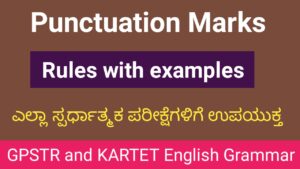
Punctuation marks with examples in English grammar. This is very useful for CTET, GPSTR and KARTET exam. English grammar for all competitive exams.
To get more videos for all competitive exams visit our YouTube channel. In this channel we explained all English grammar for competitive exams.
Punctuation is the system of signs or symbols given to a reader to show how a sentence is constructed and how it should be read. Punctuation marks with examples.
English language has many punctuation marks and you will usually learn to use many of them as you master the language.
1.Full stop .
2.Comma ,
3.Colon :
4.Semi-colon ;
5.Question mark ?
6.Round brackets ( )
7.Square brackets [ ]
8.Quotation mark “ “
9.Apostrophe ‘
10. Exclamation mark !
11. Slash /
1.Full stop .
A full stop is one of the most commonly used punctuation marks in the English language.
Rules:
1.Commonly used at the end of the declarative sentence, or a statement that is considered to be complete.
2.This mark is also used following an abbreviation.
3.It also show the end of a group of words that don’t form a typical sentence.
Examples:
Ramu was studying in the library.
Mr. John has written a novel.
He studied M.A, B.ed.
2. Question mark ?
We use question mark after an interrogative sentence in English.
Rules: 1.We use this mark to enquiry.
2.It is also used in Wh question, Yes/No types of question and question tag.
Examples:
Why are you so worried?
Do you want to go now?
He is playing chess. Isn’t he?
Is this your house?
3. Quotation marks “ “
We use quotation marks for direct quotations in English. These are the stated quotes or saying of particular person.
Rules: 1.We use it for direct words of the writer or speaker.
2. Used to write titles.
3. To highlight a particular word or sentence.
Examples:
Sheetal said, “We are planning to go tour next month.”
We are watching “Mungaru Male” film in the theatre.
I don’t know the meaning of ‘Abandon’ in this text.
4. Apostrophe ‘
Apostrophe is widely used in English.
Rules:
1. Used to show certain letters have been omitted from a word.
2. Used to show possessive form of a noun.
3. Used to indicate the plural form of lowercase letters.
Examples:
He’s not ready to sacrifice.
Janu is writing children’s story.
He draw the pictures’ of many birds.
5. Comma ,
Comma is also a familiar punctuation mark in English.
Rules:
1. Used to show difference between two separate ideas or elements within a sentence.
2. Used to separate numbers.
3. Used to separate parts of the date.
4. Used to set off a question tag from the rest of the sentence.
Examples:
W sold some books, and we sold some tables.
My son is counting 1, 2, 3, everyday.
Kiran was born April 4, 2013.
Sinchana was singing a song, wasn’t she?
6. Hyphen –
Many people make mistake in using hyphen ( – ) and dash ( _ )
Rules:
1. Used to join two or more words together into a compound term.
2. To link prefixes to words.
3. To indicate word breaks.
Examples:
My ten-year-old boy loves playing.
He joined pre-university courses.
She was born during twentieth-century.
We need to develop self-confidence.
7. Exclamation mark !
We use this mark in exclamatory sentences.
Rules:
1. It is used to show emphasis.
2. It can be used in the middle or at the end of the sentence.
3. Used to show strong emotion, command or order.
Examples:
What a lovely flower it is!
Help !
John, don’t go there !
Hurrah ! We won the match.
8. Colon :
It is a common punctuation mark with a varied number of uses.
Rules:
1. Used to introduce a quotation.
2. Used to separate two independent clauses.
3. It can be used to show emphasis.
Examples:
He has two choices: Read the novel or prepare for food.
I have one aim: To travel around the world.
We need these items: table spoon, cooker and fruits.
It is not a gold: It is made of metal.
9. Semi colon ;
It is a common punctuation mark with a varied number of uses.
Rules: 1.It is used to separate two independent clauses with still demonstrating that a close relationship exists between them.
2.Used to show the connection between two statements than a full stop would.
Examples:
My uncle is a teacher; my aunty is a doctor.
There are 4 members in the team; two from India; two from America.
Chintu sleeps with his grandma; he was afraid of darkness.
10. Slash /
It is a common punctuation mark with a varied number of uses.
Rules: 1.Used to show alternatives in a sentence. 2.Used to separate parts of the web address. 3.Used for fractions.
Examples:
Please press refresh /reload button.
1/3 = One third.
Home
Watch this video for explanation of this topic. Punctuation marks with examples